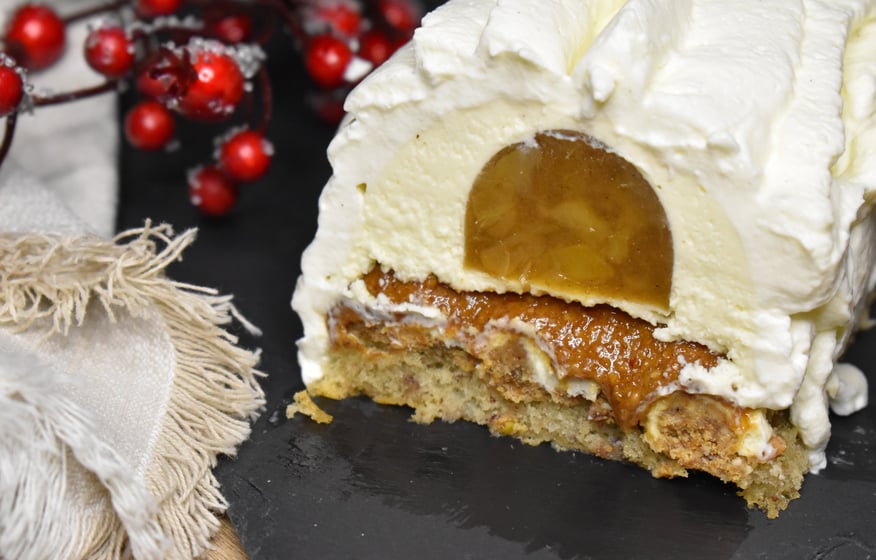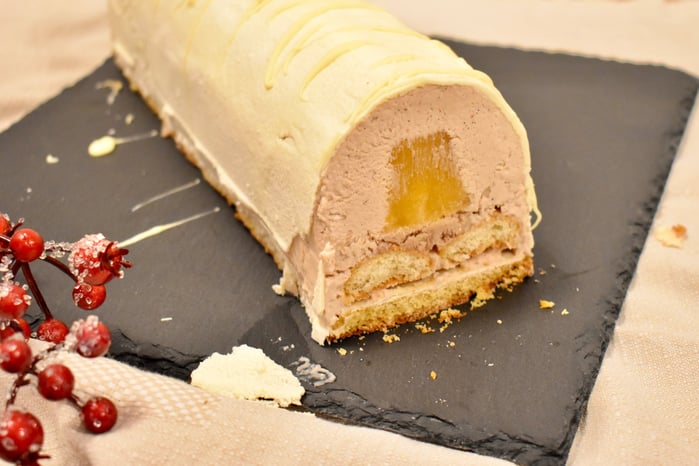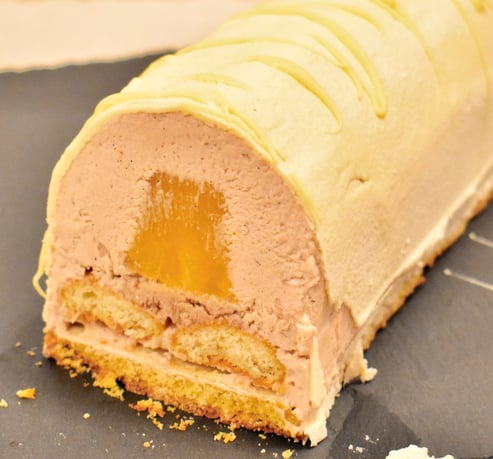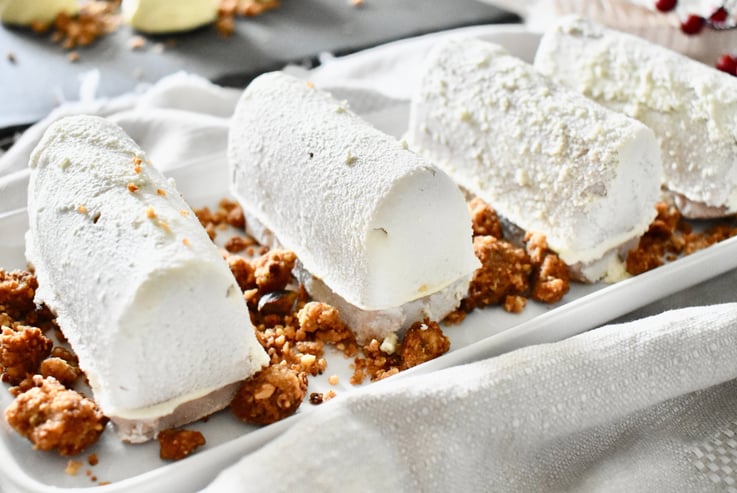Pecan, Vanilla & Pear Yule Log Recipe
This Yule Log is one of my favourite, it's delicate and decadent at the same time. Impress your guests with this beautiful Christmas dessert.
by Aliza
12/16/20248 min read
Chestnut and Clementine Yule Log: A Gourmet Holiday Creation
This holiday season, I resolved to elevate my baking game by crafting not one but at least two "bûches de Noël" (Yule logs). Instead of the traditional rolled sponge cake, I opted for a more gourmet entremets-style bûche. To fully commit to this project, I indulged in some new baking tools, even though I already had plenty at home. Among my purchases were three large 1kg bags of Cacao Barry chocolate (one for each kind of chocolate)—the "professional-grade" kind. Yes, it was expensive, but was it worth it? Absolutely! Compared to my usual Lindt or occasional even more pricier Valrhona chocolate, this larger quantity felt like a better deal, especially since it was on sale (a small win for my wallet and baking ambitions).
The first bûche I created this year is a harmony of chestnut and clementine flavours, a combination that is nothing short of divine. The clementine’s bright zing complements the subtle, nutty sweetness of the chestnut, preventing it from being too subdued. To keep control over the sweetness, I used raw, unsweetened chestnut purée as my base.
I have always been intrigued by pastries made with chestnuts, however, I never had the chance to try them, as most of the time they include alcohol, which is not suitable for me as a Muslim. While creating my own bûche, I discovered why pastry chefs rely on alcohol or excessive sugar in these desserts: chestnut paste is surprisingly bland, bland and tasteless. I love roasted chestnuts and expected a similar taste, well without the roasted taste of course, but, still, I anticipated... something. So to enhance the taste, I decided to incorporate clementine zest and vanilla into my eggless "crémeux," which served as the base for an eggless "bavaroise." This resulted in a sophisticated and harmonious flavour profile. The zests uplift the creamy nutty flavour of the chestnut with their citrus accent while the vanilla brings balance.
This dessert features several layers of textures and flavours: the eggless chestnut "crémeux" which served as a base for my no egg chestnut and vanilla bavaroise and a refreshing clementine insert made with pressed juice and fruit segments, ladyfingers and a vanilla "sablé breton" (French salted butter cookie) to add a delightful crunch, its texture preserved by a thin coating of white chocolate, a technique known as “chablonner” in French, to prevent it from getting getting soggy from being in direct contact with the cream.
For the ladyfingers, I admit I cheated a bit and used the store-bought ones that I already had at home. While they worked perfectly, they were slightly sweeter than I prefer, so I adjusted the sugar in my crémeux accordingly.
Note that it is important to make the insert first to give it time to set in the freezer while you make the other preparations.
For optimal results, I recommend preparing the Yule log a day in advance to ensure it is sufficiently chilled or frozen when applying the velvet spray. The dessert must be frozen to achieve that beautiful, pearly finish. After spraying, allow it to thaw in the refrigerator for at least 6 hours before serving.
Material:
Acetate sheets (papier guitare)
Ingredients:
For a 30 cm yule mold (approximately 10 to 12 servings):
The Clementine Insert:
Fresh clementine juice: 300 ml (from about 6–7 clementines)
Peeled clementine segments: 150 g (from about 2–3 clementines, membranes removed)
Fish gelatine powder: 9 g (you might need to adjust slightly based on your specific gelatine brand/type)
Water: 40 g (for blooming the gelatine)
Optional: ½ tsp clementine zest (finely grated, for extra citrus aroma)
The Sablé Breton or French Salted Butter Cookies (Christophe Felder’s recipe)
3 egg yolks130g caster sugar
150g room temperature butter
200g flour
1big pinch of sea salt
11g baking powder
Some melted white chocolate for the “chablonnage” (coating the biscuit).
The Eggless Chestnut Crémeux:
Yield: ~550–600 g
500 ml milk
½ vanilla pod (split, seeds scraped; pod included)
50 g cornstarch
100 g sugar (adjust if using sweetened chestnut purée)
1 tsp orange and clementine zests
70-80 g chestnut purée (unsweetened)
80 g unsalted butter
1 pinch sea salt
The Chestnut Bavaroise:
Eggless chestnut crémeux: 300 g
Whipping cream (35% fat): 300 g (200 g whipped + 100 g liquid)
Fish gelatine powder: 8 g (you can use any kind kind of gelatine you’re used to but you’ll need to adjust the quantity)
Water (for blooming gelatine): 40 g (5x the weight of the gelatine)
Instructions:
The Clementine Insert:
Prepare the fish gelatine:
Sprinkle the fish gelatine powder over 40 g of cold water to bloom. Let it sit for 5–10 minutes until fully hydrated.
Warm the Juice:
In a saucepan, heat the clementine juice over medium heat until warm (not boiling). This will dissolve the gelatine and ensure even mixing. Stir in the clementine zest if using.
Add gelatine:
Remove the saucepan from the heat. Stir in the bloomed fish gelatin until completely dissolved. Make sure there are no lumps or undissolved bits.
Assemble the insert:
Pour a thin layer of the insert mixture into your insert mould. Scatter some of the peeled clementine segments evenly across the mould. Continue layering juice and segments until the mould is filled.
Set and freeze:
Allow the insert to cool to room temperature. Refrigerate until fully set (about 3 hours), then transfer to the freezer and freeze completely before using in your bûche.
Notes:
Balancing Acidity: If the clementines are very tart, consider adding a small pinch of sea salt or a few drops of liquid sweetener like honey to round out the flavour.
Segments: Make sure the clementine pieces are fully submerged in the mixture to avoid air pockets.
The Sablé Breton or French Salted Butter Cookies (Christophe Felder’s recipe)
With a hand or a stand mixer, mix the egg yolks with sugar until light and fluffy.
Add the butter and mix until well incorporated.
Sift together the flour, baking soda and sea salt and mix until the dough comes together. Be careful not to overmix the dough or it will be too tough and not crumbly.
Wrap the dough in some cling film and chill for 1 to 2 hours.
Preheat your oven to 180°C.
Lay the dough onto a sheet of parchment paper and spread the dough until it is about 1 or 1.5 cm thick and 30 cm wide.
Bake for 15 min according to your oven.
Transfer the sablé as soon as it is cooked. The center should still be soft but it will firm up as it cools.
with a brush spread a thin layer of melted white chocolate on top of the sablé breton to prevent it from getting soggy while in contact with the crémeux.
The Chestnut Crémeux:
Yield: ~550–600 g
Instructions:
In a saucepan, whisk together the cold milk and cornstarch.
Split the vanilla pod in half and scrape the seeds from one half.
Add the vanilla seeds and stir until the cornstarch is dissolved.
Place over low heat, stirring continuously until the mixture starts to thicken (or reaches 82–85 °C).
Add the chestnut purée, clementine zests, sugar and sea salt. Continue stirring until smooth and creamy.
Remove from heat and stir in the butter until fully incorporated.
Transfer to a bowl and cover the surface directly with cling film to prevent a skin from forming.
Let cool to room temperature, then refrigerate until ready to use.
Notes:
Adding Chestnut Purée Mid-Cooking: allows it to integrate smoothly without overheating the purée.
Adding butter at the End: Adding butter off-heat prevents separation and ensures a silky texture.
Cooking to Thicken: to check if the crémeux reached the right consistency, see if it coats the back of a spoon and if you can trace a line with your fingertip.
Sweetness: I tend to reduce the amount of sugar in my cakes recipes but if you prefer more sweetness feel free to adjust the amount of sugar. Considering I used raw unsweetened chestnut purée, I think adding 80 to 100 g of sugar is a suitable amount. If you’re using sweetened chestnut purée 70 to 80 g is a reasonable amount. Keep in mind that ladyfingers are sweet and so is the palet breton.
Tasting Note: Since raw chestnut purées can vary in bitterness or earthiness, I suggest tasting the crémeux before adding the butter as you might prefer a touch more sugar or zest at this stage.
Preservation: the crémeux keeps up to 3 days in the fridge.
The Chestnut Bavaroise:
Bloom the gelatine:
Sprinkle the fish gelatine powder over 40 g of cold water. Let it sit in the fridge for 20 minutes to hydrate.
Heat the liquid cream:
In a small saucepan, warm 100 g of liquid whipping cream to about 60 °C (hot but not boiling).
Dissolve the gelatine:
Add the bloomed gelatine to the warm cream. Stir gently until the gelatine is completely dissolved.
Incorporate the chestnut crémeux:
In a mixing bowl, whisk the chestnut crémeux to ensure it’s smooth. Gradually add the warm cream-gelatine mixture, whisking continuously to create a homogeneous base.
Cool the mixture:
Let the chestnut mixture cool to room temperature, stirring occasionally. It should not set but must be cool enough to avoid melting the whipped cream in the next step.
Whip the cream:
Whip the remaining 200 g of cream to soft peaks. Be careful not to over whip as it will harden the bavaroise.
Fold the whipped cream into the chestnut base:
Add one-third of the whipped cream to the chestnut mixture and whisk gently to lighten the base.
Fold in the remaining whipped cream carefully using a spatula, ensuring a smooth and airy texture.
Assembling the yule log:
Pour or pipe the chestnut Bavaroise into your 30 cm bûche mould.
Smooth the surface with an offset spatula making sure to coat the sides evenly and tap the mould gently to remove air bubbles.
Place the frozen insert in the middle.
Spread a layer of chestnut crémeux.
Dispose the ladyfingers along the length of the mould.
Spread another thin layer of crémeux.
Place the sablé breton.
Cover with clingfilm and place in the freezer for at least 6 hours or overnight.
Once the bûche is set and still frozen, turn it out and spray it with velvet spray for a beautiful mat and velvety finish.
What to do if you have any left over bavaroise or "crémeux"?
You can create charming mini Yule logs with a streusel or crumble base or simply use any biscuits you have on hand. I made mine with some leftover streusel I had in the freezer and some sauteed pears for freshness. If you don't feel like making an additional insert, feel free to skip it and stick to the chestnut bavaroise and/or crémeux paired with a biscuit base. It’s a versatile and delicious way to use extra ingredients!
If you have mini silicone moulds, you can easily create delightful chestnut bonbons. Start by melting some white chocolate and use either a pastry brush to coat the moulds or fill them completely before turning them over to drain the excess. Let the chocolate shells set in the fridge for about 10 minutes. Once set, fill them with chestnut bavaroise or chestnut crémeux, leaving a little space at the top for the final chocolate layer. Freeze the filled moulds for 20 minutes, then seal them with a layer of melted white chocolate. Let them set again, and voilà—your delicious chestnut bonbons are ready to enjoy!
Another way to use the chestnut cream leftovers would be to make verrines. I didn't make them but you could easily make verrines by alternating a layer of crumbled biscuit, a layer of chestnut bavaroise/crémeux and a layer of whipped cream, a light chocolate mousse or even some fruits (pear, cassis, citrus fruits, ...)


Did you make this recipe?
Please leave un comment and don't hesitate to take a picture and share it on Instagram and tag me @gentlebeautywithaliza.
I can't wait to see your pictures !
Et si on discutait ?











